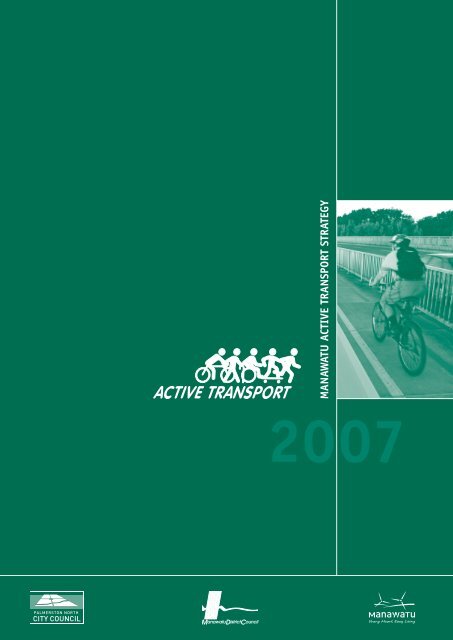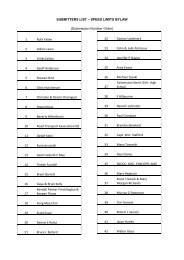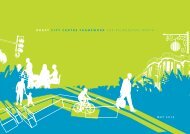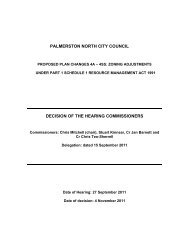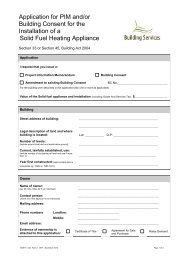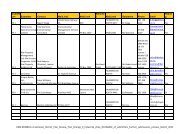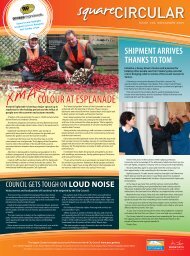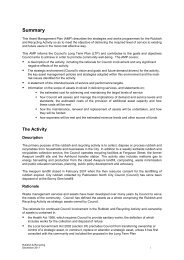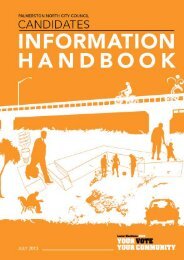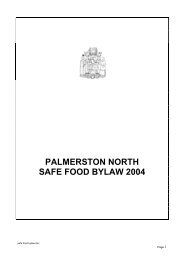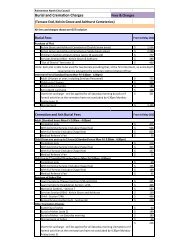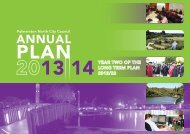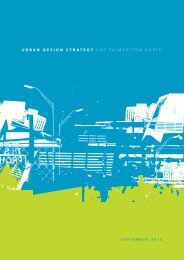Active Transport Strat Cover.indd - Palmerston North City Council
Active Transport Strat Cover.indd - Palmerston North City Council
Active Transport Strat Cover.indd - Palmerston North City Council
Create successful ePaper yourself
Turn your PDF publications into a flip-book with our unique Google optimized e-Paper software.
MANAWATU ACTIVE TRANSPORT STRATEGY<br />
2007
1<br />
MANAWATU<br />
ACTIVE<br />
TRANSPORT<br />
STRATEGY<br />
Produced by: In collaboration with staff of the Roading Division of <strong>Palmerston</strong><br />
<strong>North</strong> <strong>City</strong> <strong>Council</strong> and the Manawatu District <strong>Council</strong>.<br />
Approved for Issue by: <strong>Palmerston</strong> <strong>North</strong> <strong>City</strong> <strong>Council</strong> and Manawatu District <strong>Council</strong><br />
Dated: April 2007<br />
MANAWATU ACTIVE TRANSPORTATION STRATEGY 2007
MANAWATU ACTIVE TRANSPORTATION STRATEGY 2007 2
PNCC Mayor Heather Tanguay PNCC Chief Executive Paul Wylie MDC Mayor Ian McKelvie MDC Chief Executive Rod Titcombe<br />
3<br />
WELCOME<br />
We are pleased to introduce you to the fi rst pedestrian and cycling strategy for the Manawatu,<br />
a joint venture between <strong>Palmerston</strong> <strong>North</strong> <strong>City</strong> <strong>Council</strong> (PNCC) and Manawatu District <strong>Council</strong><br />
(MDC). In these districts we enjoy relatively short distances in and around towns and the<br />
city, a mild climate, fl at terrain and jeweled surroundings; Manawatu is well placed for<br />
making active transport an attractive and easy choice for everyone. <strong>Active</strong> transportation<br />
includes those forms of transport that have a component of physical activity, such as cycling,<br />
jogging, skateboarding and walking.<br />
We have developed this document with the help of many agencies and interest groups.<br />
In particular, we would like to thank the members of the Manawatu <strong>Active</strong> <strong>Transport</strong><br />
<strong>Strat</strong>egy Working Group for assisting in the development of this strategy. Together with our<br />
communities, we are committed to the vision of this strategy:<br />
MORE MANAWATU PEOPLE AND VISITORS USE ACTIVE TRANSPORT<br />
MORE OFTEN FOR TRAVEL, HEALTH AND ENJOYMENT.<br />
This strategy aims to be a community document with <strong>Council</strong> clearly having a role but not<br />
able to directly provide or infl uence all areas of the plan. Partnerships are key elements<br />
and without your support and input, we can only achieve limited success. Please think<br />
about areas you can be involved in and what needs to happen to achieve the results we are<br />
aiming towards. The Manawatu will become an active transportation centre of excellence<br />
in New Zealand!<br />
A commitment to your own health starts with the fi rst step. We expect to see more people<br />
leaving the car at home for some or all of their travel. So for the good of your health and the<br />
community’s health, get moving!<br />
COME ON MANAWATU PUT YOUR BEST FOOT FORWARD AND<br />
WORK WITH US TO MAKE THIS HAPPEN!<br />
We’ll see you out there!<br />
MANAWATU ACTIVE TRANSPORTATION STRATEGY 2007
MANAWATU ACTIVE TRANSPORTATION STRATEGY 2007 4
5<br />
TABLE OF<br />
CONTENTS<br />
1 INTRODUCTION 7<br />
2 THE FOUR E’S 9<br />
2.1 Engineering 9<br />
2.2 Encouragement 10<br />
2.3 Enforcement 10<br />
2.4 Education 11<br />
3 VISION AND GOALS 13<br />
3.1 Vision 13<br />
3.2 Goals, Objectives and Action Plan 14<br />
4 INDICATORS 23<br />
5 BACKGROUND 25<br />
6 GLOSSARY OF TERMS 27<br />
7 STRATEGY WORKING GROUP 29<br />
APPENDIX A WALKING AND CYCLING NETWORK PLANS 31<br />
APPENDIX B POLICY CONTEXT 37<br />
Appendix B.1 National 37<br />
Appendix B.2 Regional 38<br />
Appendix B.3 Local/District Policies and Initiatives 39<br />
APPENDIX C DATA AND TRENDS 43<br />
Appendix C.1 Census Data 43<br />
Appendix C.2 Pedestrian and Cycle Crash Analysis for Manawatu 1995-2004 44<br />
APPENDIX D BENEFITS OF ACTIVE TRANSPORT MODES 47<br />
Appendix D.1 Individual Benefi ts 47<br />
Appendix D.2 <strong>Transport</strong> System Benefi ts 47<br />
Appendix D.3 Economic Benefi ts 48<br />
Appendix D.4 Community Benefi ts 49<br />
Appendix D.5 Environmental Benefi ts 49<br />
APPENDIX E: DESIGN GUIDELINES FOR FACILITIES 51<br />
APPENDIX F: ENCOURAGEMENT 53<br />
APPENDIX G: FUNDING 55<br />
MANAWATU ACTIVE TRANSPORTATION STRATEGY 2007
MANAWATU ACTIVE TRANSPORTATION STRATEGY 2007 6
1<br />
7<br />
INTRODUCTION<br />
The Manawatu <strong>Active</strong> <strong>Transport</strong> <strong>Strat</strong>egy, for Pedestrians 1 and Cyclists is a joint venture<br />
between PNCC 2 and MDC. However, the vision of this strategy could not be realised without<br />
the assistance and support of partner agencies committed to achieving positive outcomes<br />
in our community.<br />
Partners include:<br />
• Sport Manawatu<br />
• Destination Manawatu<br />
• RoadSafe Central<br />
• Transit New Zealand<br />
• Land <strong>Transport</strong> New Zealand (LTNZ)<br />
• New Zealand Police<br />
• Accident Compensation Corporation (ACC)<br />
• Public Health<br />
• Sport Clubs<br />
• Advocacy Groups<br />
• Road Sense<br />
While vitally important, it is widely recognised that engineering alone has limited ability to<br />
deliver on sought objectives. Throughout the development of this strategy a collaborative<br />
approach combining the aspects of Engineering, Encouragement, Enforcement and Education<br />
(i.e. the 4 E’s) has been taken.<br />
It’s time for Manawatu people to work together towards a community where “More Manawatu<br />
people and visitors use active transport more often for travel, health and enjoyment”.<br />
1 Pedestrians - includes those with intellectual, sensory and physical impairments and is therefore intended to provide for<br />
the needs of the elderly and disabled.<br />
2 PNCC adopted its Bike Plan in 1998, signalling its intent to encourage cycling in one of New Zealand’s leading cycling<br />
cities. This strategy supersede’s the Bike Plan.<br />
MANAWATU ACTIVE TRANSPORTATION STRATEGY 2007
MANAWATU ACTIVE TRANSPORTATION STRATEGY 2007 8
2<br />
ENGINEERING - ENCOURAGEMENT - ENFORCEMENT - EDUCATION<br />
9<br />
THE FOUR E’S<br />
2.1 ENGINEERING<br />
The ‘Four E’s’ is a term describing often overlapping areas of agency responsibility regarding<br />
active transport. Individually, Engineering, Encouragement, Enforcement and Education<br />
are interventions used in central government’s Road Safety 2010 strategy 3 . The following<br />
describes each intervention of the ‘Four E’s’ and details where agencies are most likely to<br />
be playing a key role.<br />
The responsibility for ‘Engineering’ rests with PNCC, MDC and the national road controlling<br />
authority, Transit New Zealand. Engineers recognise that pedestrians and cyclists are the<br />
most vulnerable of road users and because of this there is a need to maintain a higher safety<br />
focus for these road users. In keeping with best practice standards the roading network is<br />
being upgraded continuously to improve accident blackspots such as intersections, pedestrian<br />
crossings, and kerb ramps.<br />
Both local and international experience indicates that developing connected facilities in a<br />
pedestrian and cycling network better serves the needs of the users than isolated facilities.<br />
For these reasons an <strong>Active</strong> <strong>Transport</strong> Network / Principal Cycle Network has been developed<br />
(please refer to supporting documentation). When the roads were considered for inclusion<br />
in the <strong>Active</strong> <strong>Transport</strong> Network, the following attributes were reviewed:<br />
ENGINEERING PLANNING<br />
• Carriageway width • Road hierarchy<br />
• Presence and width of footpaths • Land use<br />
• Intersection control • Origins and destinations<br />
• Centre and edge marking • Connectivity<br />
• Shoulder width • Integration with passenger<br />
• Road surface transport interchanges<br />
• Road gradient • Aesthetics<br />
• Traffi c volumes • Spacing of facilities, toilets/rest areas,<br />
• Traffi c speed water, food, accommodation<br />
• Traffi c composition (i.e. % of truck traffi c)<br />
3 http://www.landtransport.govt.nz/strategy-2010/<br />
MANAWATU ACTIVE TRANSPORTATION STRATEGY 2007
2.2 ENCOURAGEMENT<br />
2.3 ENFORCEMENT<br />
The responsibility for ‘Encouragement’ rests with many agencies. Sport Manawatu, Public<br />
Health and RoadSafe Central have bigger roles to play than others, yet all network partners<br />
and advocacy groups support encouragement activities. While each partner has varied<br />
reasons for increasing pedestrian and cyclist activity, all agree that our communities’ key<br />
benefi ts are in reducing vehicular trips.<br />
Examples of encouragement could be programs or projects that have been designed to<br />
promote the increased use of <strong>Active</strong> <strong>Transport</strong> modes and/or reducing vehicle trips for short<br />
journeys. Passenger <strong>Transport</strong> may directly benefi t from these programs. All partners to this<br />
strategy clearly see ‘Encouragement’ as a component that complements the other E’s.<br />
Partners to this strategy recognise that other sporting activities such as mountain biking, can<br />
encourage riders to choose active transport modes for commuting purposes. Consequently,<br />
all partners will encourage other sporting and recreational activities that have commuting<br />
benefi ts. See Appendix F for more detail.<br />
The primary responsibility for ‘Enforcement’ rests with the New Zealand Police however both<br />
PNCC and MDC are able to contribute to ‘Enforcement’ through a parking enforcement role<br />
within the community.<br />
In addition to enforcement, the Police have a role to play in targeting traffi c offenders with<br />
educational activities, advertising and promotion campaigns.<br />
It is a legal requirement for all crashes to be reported to the Police. Land <strong>Transport</strong> New<br />
Zealand captures this information in a database, where crashes are then analysed, so key<br />
agencies collaborate on improving problematic areas.<br />
MANAWATU ACTIVE TRANSPORTATION STRATEGY 2007 10
2.4 EDUCATION<br />
11<br />
The primary responsibility for road user ‘Education’ and wider road safety rests with Land<br />
<strong>Transport</strong> New Zealand. It is also supported by many other agencies such as New Zealand<br />
Police, Accident Compensation Corporation, Horizons Regional <strong>Council</strong> and RoadSafe Central<br />
e.g. New Zealand Police play a large role in ‘Education’ by providing programs to local schools<br />
to teach them how to comply with road rules and how to travel safely on the roads. These<br />
programs are delivered through the ‘Police Education Offi cers’.<br />
Land <strong>Transport</strong> New Zealand and New Zealand Police actions are targeted around the major<br />
contributing factors to crashes. Pedestrians’ and cyclists’ safety can be improved through<br />
better education of all road users, including motorists.<br />
At a school level, walking school buses teach children road safety behaviour on their journey<br />
to and from school. The Land <strong>Transport</strong> New Zealand “RoadSense” programme delivers road<br />
safety messages as part of the school curriculum.<br />
Locally, RoadSafe Central is working with the community to develop localised community<br />
road safety projects. In addition, Sport Manawatu and Public Health are developing regional<br />
initiatives that directly benefi t our communities by increasing awareness of pedestrian and<br />
cycling benefi ts.<br />
Nationally, Kidsafe awareness campaigns have highlighted key child road safety issues<br />
including pedestrian and cycle safety. Bike Wise Week also highlights key safety messages<br />
when encouraging the use of bicycles for short journeys.<br />
As central government further develops its implementation programme for the ‘Getting there<br />
– on foot, by cycle’ strategy, further educational opportunities will present themselves. Local<br />
Authorities and their partners will play a key role in the collaboration and implementation<br />
of these opportunities.<br />
MANAWATU ACTIVE TRANSPORTATION STRATEGY 2007
MANAWATU ACTIVE TRANSPORTATION STRATEGY 2007 12
3.1 VISION<br />
3<br />
13<br />
VISION AND<br />
GOALS<br />
The vision of this strategy is that:<br />
MORE MANAWATU PEOPLE AND VISITORS USE ACTIVE TRANSPORT<br />
MORE OFTEN FOR TRAVEL, HEALTH AND ENJOYMENT<br />
In an effort to achieve this vision, network partners will work towards the following objectives<br />
and actions.<br />
A large number of projects have been suggested by the working group or requested by members<br />
of the public and interested groups. Not all of these projects were identifi ed individually as<br />
several of the generic action points eliminate the need for separate identifi cation.<br />
While the partners are committed to pursuing these actions, implementation will necessarily be<br />
tailored to budgets and resource allocation. For this reason, setting a fi rm priority and target<br />
for each action is not included. As this strategic document is intended to offer long term<br />
guidance, budgets will change based on Annual Plans and potential new funding streams.<br />
<strong>Palmerston</strong> <strong>North</strong> <strong>City</strong> and Manawatu District <strong>Council</strong>’s Commitments are shown in Appendix<br />
G, “Funding”.<br />
MANAWATU ACTIVE TRANSPORTATION STRATEGY 2007
3.2 GOALS, OBJECTIVES AND ACTION PLAN<br />
GOAL 1: TO PROMOTE MORE USE OF ACTIVE TRANSPORT MODES FOR HEALTH AND ENJOYMENT AND AS ALTERNATIVES TO<br />
PRIVATE MOTOR VEHICLE TRAVEL<br />
Encouragement – Education<br />
RESPONSIBILITY<br />
OBJECTIVES SUMMARY OF ACTIONS, PROJECTS AND PROGRAMMES TARGET<br />
(WHERE APPROPRIATE)<br />
PNCC, MDC and other partners<br />
May 2007 – Ongoing<br />
1.1.1 Promote Manawatu <strong>Active</strong> <strong>Transport</strong> <strong>Strat</strong>egy<br />
• Develop a promotional campaign to raise awareness of the<br />
Ongoing<br />
strategy<br />
• Regular review and implementation<br />
1.1 To encourage more people to use<br />
active transportation more often<br />
instead of driving cars for day to day<br />
trips, tourism and recreation.<br />
PNCC, MDC, Sport Manawatu, Public<br />
Health and other partners<br />
October 2007<br />
1.1.2 Promote <strong>Active</strong> <strong>Transport</strong> Network<br />
• Develop a promotional campaign to raise awareness and<br />
Ongoing<br />
encourage use of the existing walk and cycleway networks<br />
• Regular review and implementation<br />
All partners<br />
July 2007<br />
1.1.3 Promote End of trip facilities such as secure parking and lockers<br />
• Develop a promotional campaign to raise awareness and<br />
Ongoing<br />
encourage use of existing end of trip facilities<br />
• Regular review and implementation<br />
PNCC, MDC, Transit, LTNZ,<br />
RoadSafe Central, Horizons and<br />
January 2008<br />
1.1.4 Safe Routes to Schools<br />
• Investigate the possibilities of ‘Safe Routes to School’<br />
other partners<br />
programmes<br />
• Develop implementation programmes<br />
July 2008<br />
Ongoing<br />
• Regular review and implementation<br />
MANAWATU ACTIVE TRANSPORTATION STRATEGY 2007 14<br />
Sport Manawatu, Horizons, Public<br />
Health and other partners<br />
Ongoing<br />
1.1.5 Workplace and Travel Plans<br />
• Encouragement of workplace and travel plans to employers<br />
and educational institutes<br />
1.1.6 Support active transport events where appropriate Ongoing PNCC, MDC, RoadSafe Central, ACC,<br />
NZ Police, Public Health and other<br />
partners
RESPONSIBILITY<br />
OBJECTIVES SUMMARY OF ACTIONS, PROJECTS AND PROGRAMMES TARGET<br />
(WHERE APPROPRIATE)<br />
Sport Manawatu and other partners<br />
Ongoing<br />
1.1.7 Promote active transport events<br />
• Coordinate active transport events with the support of<br />
other network partners and agencies<br />
NZ Police, RoadSense, RoadSafe<br />
Central and other partners<br />
Ongoing<br />
1.2.1 Road user behaviour education programme for school students<br />
• Deliver the programme to all primary and secondary<br />
1.2 To provide safety, education and<br />
enforcement programmes to advance<br />
schools in the Manawatu and <strong>Palmerston</strong> <strong>North</strong> areas<br />
active transport<br />
15<br />
LTNZ, RoadSafe Central, Transit NZ<br />
and other partners<br />
Ongoing<br />
1.2.2 Road user behaviour education programme for the community<br />
• Deliver the programme in the Manawatu and <strong>Palmerston</strong><br />
<strong>North</strong> areas<br />
PNCC, MDC, NZ Police, RoadSafe<br />
Central and other partners<br />
November 2007<br />
1.2.3 Parking<br />
• Develop a promotional campaign to raise awareness of<br />
parking infringements affecting active transport<br />
Ongoing PNCC, MDC, Horizons, RoadSafe<br />
Central and other partners<br />
1.3.1 To develop programmes/projects that enhance community<br />
perception of <strong>Active</strong> <strong>Transport</strong> modes and program them for<br />
implementation<br />
• To act as role models in the community<br />
• Biannual surveys to measure community attitudes towards<br />
1.3 To improve the image, social<br />
acceptability and community<br />
awareness of the benefi ts of active<br />
transport<br />
active transport modes<br />
MANAWATU ACTIVE TRANSPORTATION STRATEGY 2007<br />
Ongoing PNCC, MDC, Horizons, RoadSafe<br />
Central and other partners<br />
1.4.1 • Through Communitrak survey<br />
• Through ongoing community anecdotal feedback<br />
1.4 Monitor satisfaction of active<br />
transport programmes/projects<br />
1.5.1 Promote active transport tourism options where appropriate Ongoing Destination Manawatu and other<br />
partners<br />
1.5 To ensure the tourism potential of<br />
active transport are realised
GOAL 2: TO DEVELOP A SAFE, CONVENIENT AND ATTRACTIVE TRAVEL NETWORK FOR ACTIVE TRANSPORT<br />
Engineering - Encouragement<br />
RESPONSIBILITY<br />
OBJECTIVES SUMMARY OF ACTIONS, PROJECTS AND PROGRAMMES TARGET<br />
(WHERE<br />
APPROPRIATE)<br />
2.1.1 Cater for all road users in new designs Ongoing PNCC, MDC, Transit<br />
2.1 To ensure new and existing roads and<br />
footpaths are compatible with the<br />
needs of pedestrians and cyclists<br />
Ongoing PNCC, MDC<br />
2.1.2 Review road design policies with a view to applying Design<br />
Guidelines for Facilities (Appendix ( E)<br />
2.1.3 Develop policy regarding lighting of new sealed pathways December 2008 PNCC, MDC<br />
Ongoing Transit<br />
2.1.4 Review State Highway design with a view of applying Design<br />
Guidelines for Facilities (Appendix ( E)<br />
Ongoing PNCC, MDC<br />
2.1.5 Investigate and action <strong>Active</strong> <strong>Transport</strong> Network / Principal Cycle<br />
Network (Appendix ( A)<br />
Ongoing PNCC, MDC, Transit<br />
2.1.6 Review intersections to determine suitability for pedestrians and<br />
cyclists and implement any improvements<br />
Ongoing PNCC, MDC, Transit<br />
2.1.7 Consider the needs of pedestrians and cyclists with any new road<br />
or intersection upgrade<br />
Ongoing PNCC, MDC, Transit<br />
2.1.8 Review roads and bridges to ensure they are suitable for<br />
pedestrians and cyclists; implement any improvements<br />
MANAWATU ACTIVE TRANSPORTATION STRATEGY 2007 16<br />
Ongoing PNCC, MDC, Transit, LTNZ<br />
2.1.9 Consider where there are opportunities to reduce speed limits on<br />
open road and around school areas (urban & rural)
RESPONSIBILITY<br />
OBJECTIVES SUMMARY OF ACTIONS, PROJECTS AND PROGRAMMES TARGET<br />
(WHERE<br />
APPROPRIATE)<br />
PNCC, MDC, Transit<br />
Ongoing<br />
2.1.10 Additional maintenance<br />
• of segregated cycle routes (and footpaths/walkways where<br />
Ongoing<br />
appropriate) will occur in response to seasonal demand<br />
• in response to complaints that compromise safety within<br />
48hrs<br />
• Water blast footpath on a 5 to 7 year cycle, as required<br />
17<br />
Periodically<br />
• Investigate improved broken glass clearance system<br />
• Road shoulder as part of the annual reseal program<br />
Ongoing PNCC, MDC, Transit<br />
2.1.11 Regular checks of lighting on pedestrian and cycle routes will be<br />
carried out. Repairs of defects will be implemented as soon as<br />
possible, but no more than 48hrs after notifi cation<br />
Ongoing PNCC, MDC, Transit<br />
2.1.12 To undertake a review of all lighting on existing walkways and<br />
cycle paths. Implement new lighting where appropriate<br />
Ongoing PNCC, MDC, Transit<br />
2.1.13 Investigate the possible reduction of urban speed limit below 50<br />
km/h (full or part time) in high pedestrian/cycle areas<br />
Ongoing PNCC, MDC<br />
2.1.14 Promote “Report a Hazard” system (e.g. advertising, rates demand<br />
letter, community newsletter)<br />
MANAWATU ACTIVE TRANSPORTATION STRATEGY 2007<br />
Ongoing PNCC, MDC<br />
2.1.15 Investigate width of existing footpaths and widen where<br />
appropriate<br />
Ongoing PNCC, MDC<br />
2.1.16 Investigate and develop a programme for pedestrian crossing<br />
points and implement improvements<br />
Ongoing PNCC, MDC<br />
2.1.17 Investigate and develop a programme for converting sump<br />
grates<br />
Ongoing PNCC, MDC, Transit,<br />
2.1.18 Investigate and develop a programme for removing isolated<br />
impediments on State Highways within <strong>Palmerston</strong> <strong>North</strong> <strong>City</strong><br />
and Manawatu District
RESPONSIBILITY<br />
OBJECTIVES SUMMARY OF ACTIONS, PROJECTS AND PROGRAMMES TARGET<br />
(WHERE<br />
APPROPRIATE)<br />
Ongoing PNCC, MDC, Transit, LTNZ<br />
2.2.1 Traffi c Calming Devices (LATM’s)<br />
• Ensure use of traffi c calming devices on the <strong>Active</strong> <strong>Transport</strong><br />
Network takes into consideration the needs of cyclists and<br />
pedestrians<br />
2.2 To ensure that Local Area Traffi c<br />
Management (LATM) plans and the<br />
<strong>Council</strong>’s Safety Management System<br />
for roads support active transport<br />
• Investigate and prioritise implementation of traffi c calming<br />
devices on roads, where appropriate<br />
Ongoing MDC, LTNZ<br />
2.2.2 Review the Safety Management System from a pedestrian and<br />
cyclist’s perspective<br />
Ongoing PNCC, MDC<br />
2.3.1 Consider pedestrian, cycle and public transport linkages through<br />
future subdivisions<br />
2.3 To ensure that convenient and<br />
attractive linkages are developed<br />
between new subdivisions and within<br />
parks and reserves<br />
Ongoing PNCC, MDC<br />
2.4.1 Investigation of pathways and cycle routes<br />
• Manfeild Park Pathway<br />
2.4 To provide pedestrians and cyclists<br />
with good linkages within the district<br />
• Kowhai to Kitchener Park Pathway<br />
• Te Araroa Trail<br />
and neighbouring districts<br />
• Regional pedestrian and cycle routes<br />
• Rural routes (Appendix A)<br />
Ongoing PNCC, MDC, Transit<br />
2.4.2 Bridges (Urban/Rural)<br />
• Investigate river crossing for pedestrians and cyclists<br />
upstream and downstream of the existing Fitzherbert<br />
Avenue Bridge<br />
• Any future road bridges/underpasses or river crossings<br />
should consider access for pedestrians and cyclists<br />
• All existing bridges urban/rural should be investigated for<br />
active transport user safety and improvements programmed<br />
MANAWATU ACTIVE TRANSPORTATION STRATEGY 2007 18<br />
accordingly
RESPONSIBILITY<br />
OBJECTIVES SUMMARY OF ACTIONS, PROJECTS AND PROGRAMMES TARGET<br />
(WHERE<br />
APPROPRIATE)<br />
Ongoing PNCC, MDC, Transit<br />
2.5.1 Use land designations where necessary and required to achieve<br />
linkages<br />
2.5 To expand and enhance the active<br />
transport networks and facilities in<br />
the Manawatu<br />
Ongoing PNCC, MDC<br />
2.5.2 Utilise unformed legal road for active transport corridors, where<br />
appropriate<br />
19<br />
Ongoing PNCC, MDC, and other partners<br />
2.5.3 Investigate and implement improvements to end of trip facilities<br />
including cycle and mobility scooter parking, showers and<br />
lockers<br />
February 2008 PNCC, MDC<br />
2.5.4 Develop guidelines for all cycle parking requirements for all new<br />
developments<br />
Ongoing PNCC, MDC<br />
2.5.5 Investigate need for drinking fountains and public toilets on<br />
active transport networks<br />
Ongoing PNCC, MDC, Horizons, LTNZ<br />
2.6.1 • Investigate the option of bike transport on urban buses<br />
• Include wheeled pedestrian facilities on all connecting<br />
routes, e.g. pushchair access on buses from Feilding to<br />
<strong>Palmerston</strong> <strong>North</strong><br />
2.6 To look for synergies between public<br />
transport, and active forms of<br />
transport and implement appropriate<br />
opportunities to enhance these<br />
modes of travel<br />
MANAWATU ACTIVE TRANSPORTATION STRATEGY 2007<br />
Ongoing UCOL, PNCC, MDC<br />
2.6.2 Investigate Safe bike parking, potentially including lockers and<br />
bike stands at selected bus stops<br />
Ongoing Horizons, PNCC, MDC<br />
2.6.3 Promote public transport (plus provision of bus shelters,<br />
timetables) as a measure of promoting active transport
GOAL 3: TO ENSURE ALL RELEVANT POLICIES AND PRACTICES INCLUDE AND SUPPORT ACTIVE TRANSPORTATION<br />
Engineering – Encouragement – Education - Enforcement<br />
RESPONSIBILITY<br />
OBJECTIVES SUMMARY OF ACTIONS, PROJECTS AND PROGRAMMES TARGET<br />
(WHERE APPROPRIATE)<br />
Ongoing PNCC, MDC, Transit<br />
3.1.1 Review Subdivision Standards and code of practice to ensure they<br />
comply with best practice for active transport modes<br />
3.1 To ensure that relevant resource<br />
management plans, Long Term<br />
<strong>Council</strong> Community Plan (LTCCP),<br />
land use planning and urban design,<br />
and other key plans support active<br />
transport<br />
Ongoing PNCC, MDC<br />
3.1.2 Ensure that developers of new subdivisions provide safe,<br />
convenient and attractive linkages for pedestrians and cyclists<br />
through and between subdivisions<br />
Ongoing PNCC, MDC, Transit<br />
3.1.3 Review landscape and urban streetscape policies and practices<br />
• Consider ‘Living Streets’ landscape designs for new and<br />
existing neighbourhoods 4<br />
Ongoing PNCC, MDC<br />
3.1.4 Review walking track standards (e.g. gravel vs. sealed, steps vs<br />
steep grade, disability access)<br />
Ongoing PNCC, MDC<br />
3.1.5 Review footpath standards to ensure they adequately cater for<br />
all pedestrian needs<br />
2007/2008 MDC<br />
3.1.6 Investigate the need to develop a policy for appropriate planting<br />
of trees and shrubbery adjacent to roading and active transport<br />
networks<br />
MANAWATU ACTIVE TRANSPORTATION STRATEGY 2007 20<br />
2007/2008 MDC<br />
3.1.7 To incorporate elements from the Manawatu District Leisure Plan<br />
that will enhance the <strong>Active</strong> <strong>Transport</strong> Network<br />
Ongoing PNCC, MDC<br />
3.1.8 Ensure that development neither severs existing routes without<br />
providing alternatives of equal or greater quality nor unjustly<br />
prejudicies accessibility by pedestrians and cyclists<br />
4 www.livingstreets.org.nz See Appendix E
RESPONSIBILITY<br />
OBJECTIVES SUMMARY OF ACTIONS, PROJECTS AND PROGRAMMES TARGET<br />
(WHERE APPROPRIATE)<br />
Ongoing PNCC, MDC, Transit<br />
3.1.9 Investigate practices of temporary traffi c management at<br />
roadwork sites affecting pedestrians and cyclists<br />
2008/2009 PNCC, MDC<br />
3.1.10 Develop a riverside pathway policy complementing any regional<br />
riverside plans<br />
PNCC, MDC and other partners<br />
Ongoing<br />
3.1.11 To ensure that any new or existing plans, policies consider the<br />
needs of active transport users<br />
21<br />
2009<br />
Ongoing<br />
Ongoing PNCC, MDC<br />
• Review <strong>Active</strong> <strong>Transport</strong> <strong>Strat</strong>egy<br />
• <strong>Active</strong>ly monitor progress of this strategy<br />
3.2.1 Review reseal programme for opportunities to reassess road<br />
layout which may include additional provisions for pedestrians<br />
3.2 To ensure road and park management<br />
and maintenance activities support<br />
and cyclists<br />
active transport<br />
Ongoing PNCC, MDC<br />
3.2.2 Review capital works programme for opportunities to include the<br />
needs of pedestrians and cyclists<br />
Ongoing PNCC, MDC, Transit<br />
3.2.3 Ensure the needs of active transport users are considered during<br />
maintenance activities. Conduct periodic inspections of the<br />
active transport network to pre-empt safety or access issues<br />
Ongoing PNCC, MDC, Transit<br />
3.2.4 Monitor and audit quality and quantity of pedestrian and cycling<br />
facilities<br />
MANAWATU ACTIVE TRANSPORTATION STRATEGY 2007<br />
2008 and 2011 PNCC, MDC, Transit and other<br />
partners<br />
3.3.1 Review the network plans and implementation programme for<br />
2009 and 2012 Long Term <strong>Council</strong> Community Plans and Annual<br />
3.3 To facilitate collaboration amongst all<br />
relevant sections of PNCC, MDC and<br />
Plans<br />
Transit working on issues relevant to<br />
pedestrians and cyclists<br />
Ongoing PNCC, MDC, Transit<br />
3.4.1 Consult with relevant stakeholders on strategies, policies, plans<br />
and practices<br />
3.4 To ensure that groups representing<br />
pedestrians, cyclists and the disabled<br />
are consulted at appropriate stages<br />
on all relevant strategies, policies,<br />
plans and practices
RESPONSIBILITY<br />
OBJECTIVES SUMMARY OF ACTIONS, PROJECTS AND PROGRAMMES TARGET<br />
(WHERE APPROPRIATE)<br />
July 2007 MDC<br />
3.5.1 Consider the appointment of an <strong>Active</strong> <strong>Transport</strong> Offi cer to drive<br />
the implementation of this strategy<br />
3.5 To ensure that adequate funds<br />
and other resources are made<br />
available for implementation of this<br />
strategy within relevant budgetary<br />
constraints<br />
2011 PNCC, MDC<br />
3.5.2 Review this <strong>Strat</strong>egy to ensure amended objectives are<br />
incorporated into the 2012 LTCCP<br />
3.5.3 Support this strategy with adequate funding and staff resources Ongoing PNCC, MDC, Transit<br />
Ongoing PNCC, MDC and other partners<br />
3.6.1 Encourage staff to walk and cycle to work and for short journeys<br />
related to work and private activities<br />
3.6 To act as role models in the<br />
community for good corporate<br />
behaviour supporting active forms of<br />
transport<br />
3.6.2 Provide and promote the use of bikes for staff Ongoing PNCC, MDC and other partners<br />
3.7.1 Convene a Regional <strong>Active</strong> <strong>Transport</strong> Steering Group Ongoing Horizons and other partners<br />
3.7 To encourage other agencies to ensure<br />
that all relevant strategies, policies,<br />
plans and practices for Manawatu<br />
support active transport<br />
MANAWATU ACTIVE TRANSPORTATION STRATEGY 2007 22
4<br />
23<br />
INDICATORS<br />
Progress made in realising the vision, goals and objectives of this strategy will be measured<br />
using these indicators:<br />
1 Increase the proportion of walking and cycling trips. Measures to include:<br />
• Census “Travel to Work” data 5<br />
• CBD cycle parking surveys<br />
• School cycle parking surveys<br />
• Recreational Route Cycle Counts<br />
2 Reduce the proportion of pedestrians and cyclists injured in crashes with motor<br />
vehicles on Manawatu roads, relative to the total number of casualties<br />
• As recorded in the Crash Analysis System, LTNZ database<br />
3 Increase the level of satisfaction expressed by residents regarding active transport<br />
infrastructure.<br />
• As recorded in the residents’ survey<br />
Progress reports will be completed annually.<br />
5 Census data are based on those who travel to work (i.e. excludes those who worked from home or did not travel to work).<br />
MANAWATU ACTIVE TRANSPORTATION STRATEGY 2007
MANAWATU ACTIVE TRANSPORTATION STRATEGY 2007 24
5<br />
25<br />
BACKGROUND<br />
Central government requires ‘walking and cycling’ to be given more importance at the<br />
regional and local level than previously, as noted in the NZ <strong>Transport</strong> <strong>Strat</strong>egy (2002) and the<br />
Land <strong>Transport</strong> Management Act 2003. “Getting there - on foot, by cycle” (February 2005)<br />
reinforces the importance central government places on these modes of travel. Government<br />
fi nancial support through Land <strong>Transport</strong> New Zealand for projects depends on the existence<br />
of walking and cycling strategies.<br />
Keeping these key documents in mind, <strong>Palmerston</strong> <strong>North</strong> <strong>City</strong> and Manawatu District <strong>Council</strong>s<br />
joined forces to develop a walking and cycling strategy in early 2005. Determined to create<br />
and develop a safe and seamless walking and cycling experience for their communities.<br />
Recognising the value in evolving regional linkages and local routes for pedestrians and<br />
cyclists, the offi cers took a collaborative approach to developing a ‘terms of reference’ for the<br />
project. Land <strong>Transport</strong> New Zealand funding enabled the <strong>Council</strong>s to engage MWH consultants<br />
Andrew MacBeth and Axel Wilke of Christchurch <strong>City</strong> Solutions to lead the development of a<br />
draft strategy.<br />
Keeping their walking and cycling communities at the forefront, strategy development<br />
progressed through two groups of dedicated walking and cycling enthusiasts. A working<br />
group comprising of key stakeholders from both districts set the content and direction, while<br />
a wider consultation group made valuable contributions.<br />
The overall aim of the strategy was to encourage greater use of active transport modes,<br />
which would inevitably make Manawatu a safer place in which to live, learn, work and play.<br />
It is intended to be a guiding document for both <strong>Council</strong>s to use for planning and funding<br />
the implementation of active transport routes, reinforcing the commitment required from the<br />
communities and network partners to achieve its goals.<br />
Network partners, such as Land <strong>Transport</strong> New Zealand, Transit, Public Health, Accident<br />
Compensation Corporation, RoadSafe Central, RoadSense, Sport Manawatu, Destination<br />
Manawatu and New Zealand Police, are equally committed to supporting the strategy. They<br />
will support the strategy by educating and encouraging our community to take responsibility<br />
for our health, economy, and environment by safely taking active transport into the future.<br />
The Manawatu <strong>Active</strong> <strong>Transport</strong> <strong>Strat</strong>egy supersedes <strong>Palmerston</strong> <strong>North</strong>’s Bike Plan (1998),<br />
is an action identifi ed in the Manawatu District Leisure Plan, and refl ects the New Zealand<br />
<strong>Transport</strong> <strong>Strat</strong>egy objectives of:<br />
• Assisting economic development<br />
• Assisting safety and personal security<br />
• Improving access and mobility<br />
• Protecting and promoting public health<br />
• Ensuring environmental sustainability<br />
MANAWATU ACTIVE TRANSPORTATION STRATEGY 2007
The goals of Getting there - on foot, by cycle (the national walking and cycling strategy) are:<br />
• Community environments and transport systems that support walking and cycling<br />
• More people choosing to walk and cycle, more often<br />
• Improved safety for pedestrians and cyclists<br />
Until recently, roading standards made few provisions for disabled users, pedestrians in a<br />
higher traffi c environment, or the needs of differing types of cyclists. New paradigms will need<br />
to be explored throughout New Zealand as population and land use trends are contributing<br />
to the changing transport environment. In <strong>Palmerston</strong> <strong>North</strong> policies such as commercially<br />
realistic pricing for carparking will assess more of the true market costs to motorists and<br />
increase demand for active transport facilities. The Manawatu <strong>Active</strong> <strong>Transport</strong> <strong>Strat</strong>egy is<br />
our collaborative commitment to meeting the transport challenges of the future.<br />
MANAWATU ACTIVE TRANSPORTATION STRATEGY 2007 26
6<br />
27<br />
GLOSSARY OF<br />
TERMS<br />
Action Plan Programme of proposed pedestrian and cycling projects and activities<br />
Bicycle A cycle with two wheels (see “cycle”).<br />
Cycle A vehicle designed to be propelled solely by the muscular energy of its<br />
driver(s) through pedalling.<br />
Cycle lane Part of a roadway allocated specifi cally for cycle use but which may<br />
occasionally be used by motor vehicles for turning at intersections or<br />
driveways or manoeuvring into parking spaces.<br />
Cycle Network Plan A map of the primary cycle route network and a schedule of the<br />
infrastructure projects required to develop it.<br />
Cycle path An off-road path path for cycles. It can be an exclusive cycle path, a<br />
shared-use path or a separated path (see “shared path”).<br />
Cycle route A recommended route for cyclists comprising cycle lanes, cycle paths, sign<br />
posting, pavement markings or other walking and cycling facilities.<br />
Cyclist A person riding a cycle.<br />
Footpath A path for use by pedestrians and others (see “pedestrian”).<br />
LTNZ Land <strong>Transport</strong> New Zealand is a government agency providing funding<br />
and support for New Zealand’s land transport system and road safety<br />
responsibilities. This agency was formed from the amalgamation of<br />
Transfund NZ and the Land <strong>Transport</strong> Safety Authority (LTSA) in December<br />
2004.<br />
LTCCP Long Term <strong>Council</strong> Community Plan, plan of council activities mandated<br />
by the Local Government Act<br />
Manawatu The area comprising the <strong>Palmerston</strong> <strong>North</strong> <strong>City</strong> <strong>Council</strong> and Manawatu<br />
District <strong>Council</strong>.<br />
MDC Manawatu District <strong>Council</strong><br />
Network plan Plan of existing and proposed walking and cycling facilities<br />
Pedestrian Any person on foot or who is using means of conveyance propelled by<br />
human power, other than bicycle. (As defi ned in the Pedestrian Network<br />
Planning and Facilities Design Guide, Land <strong>Transport</strong> NZ 2005). See also<br />
“walking”. This is further clarifi ed by noting that this strategy includes<br />
people with a range of sensory, physical and intellectual impairments.<br />
A pedestrian is someone walking under this defi nition.<br />
PNCC <strong>Palmerston</strong> <strong>North</strong> <strong>City</strong> <strong>Council</strong><br />
Shared path A physically separated path for pedestrians and cyclists, from motor<br />
vehicles. A path provided for use by both cyclists and pedestrians.<br />
Track An off-road path used by pedestrians and/or cyclists but not motor<br />
vehicles. Generally has an unsealed surface.<br />
Transit Transit New Zealand, agency responsible for New Zealand’s state highway<br />
network.<br />
Walking The Pedestrian Network Planning and Facilities Design Guide, Land<br />
<strong>Transport</strong> NZ 2005 defi nes walking as “the act of self-propelling along<br />
route, whether on foot or on small wheels, or assisted by additional<br />
aids” (see “pedestrian”).<br />
MANAWATU ACTIVE TRANSPORTATION STRATEGY 2007
MANAWATU ACTIVE TRANSPORTATION STRATEGY 2007 28
7<br />
29<br />
STRATEGY<br />
WORKING GROUP<br />
Many people have provided assistance and reviewed drafts of the strategy during its<br />
preparation. The assistance of all concerned is greatly appreciated - especially that of the<br />
Working Group who assisted in the development of this draft strategy. Composition of the<br />
group was as follows:<br />
Name Organisation(s) Represented<br />
Bob Nicholls Manawatu Striders<br />
Chris Teo-Sherrell Cycle Aware <strong>Palmerston</strong> <strong>North</strong> (CAPN), Living Streets Aotearoa<br />
Christine Cheyne CAPN, Massey Bicycle Users Group, Masters Cycling Club,<br />
Te Araroa Trust<br />
Colin Giles Manawatu District <strong>Council</strong> (MDC)<br />
Cushla Bowie Sport Manawatu<br />
David Curson Land <strong>Transport</strong> New Zealand (LTNZ)<br />
Donald Kerr CAPN, Manawatu Forest and Bird<br />
Frank Goldingham Te Araroa Trust, Walk New Zealand<br />
Grant Spiers Manawatu Triathlon Club<br />
Heather Mordaunt Public Health - Mid Central Health<br />
Mary Mitchell Road Safe Central, <strong>Palmerston</strong> <strong>North</strong><br />
Maurice Mildenhall Transit New Zealand<br />
Peter Lister DPA New Zealand. Phoenix Inc and Destination Manawatu<br />
(until June 2005)<br />
Sandi Morris <strong>Palmerston</strong> <strong>North</strong> <strong>City</strong> <strong>Council</strong> (PNCC)<br />
Todd Simmiss CAPN, Massey Bicycle Users Group<br />
Tracey Hunt Manawatu District <strong>Council</strong> (MDC)<br />
Andrew Macbeth MWH New Zealand Ltd, Christchurch, Working group co-ordinator<br />
Axel Wilke Christchurch <strong>City</strong> <strong>Council</strong>, Christchurch<br />
We would like to make special mention of our friend and colleague Peter Lister who<br />
unexpectedly passed away during the development of this strategy.<br />
“Peter, we sincerely hope that our work fulfi ls your vision”<br />
MANAWATU ACTIVE TRANSPORTATION STRATEGY 2007
MANAWATU ACTIVE TRANSPORTATION STRATEGY 2007 30


